Northern, Central and Southern Vietnam
 From Wikipedia - Reading time: 11 min
From Wikipedia - Reading time: 11 min
Northern Vietnam, Central Vietnam and Southern Vietnam are the three main historical, geographical and cultural regions within Vietnam. Each region consists of subregions, with considerable cultural differences originating from each subregions. The regional names below have been used by the Vietnamese governments since 1975 (see also: Subdivisions of Vietnam):
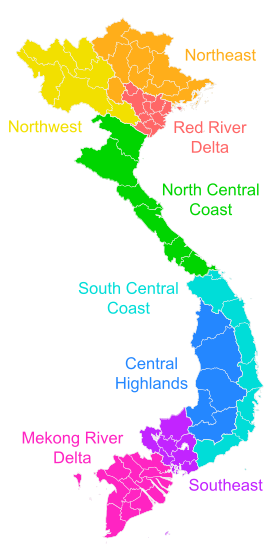
Northern Vietnam (Bắc Bộ or Tonkin) includes the following subregions:
- Northeast (Đông Bắc Bộ)
- Northwest (Tây Bắc Bộ)
- Red River Delta (Châu thổ sông Hồng or Đồng bằng sông Hồng)
Central Vietnam (Trung Bộ) includes the following subregions:
- North Central Coast (Bắc Trung Bộ)
- South Central Coast (Duyên hải Nam Trung Bộ)
- Central Highlands (Tây Nguyên – "Western Highlands")
Southern Vietnam (Nam Bộ or Cochinchina) includes the following subregions:
- Southeast (Đông Nam Bộ)
- Mekong River Delta (Đồng bằng sông Cửu Long or Tây Nam Bộ - "Southwest")
Historical context
[edit]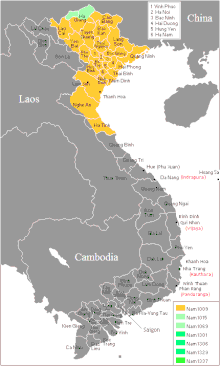

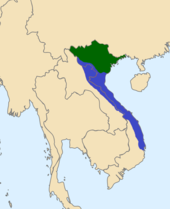
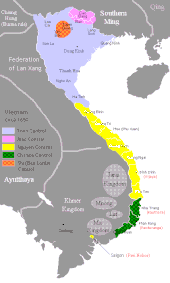
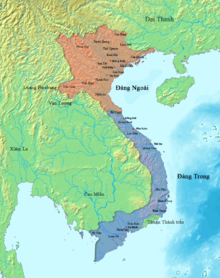
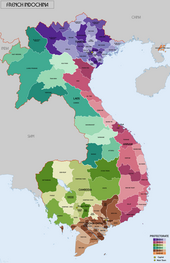
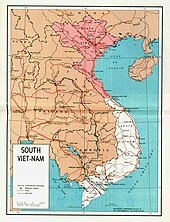
The Northern Vietnam is the traditional homeland of the ethnic Vietnamese (Kinh people) where the Đông Sơn culture existed with the first states appearing here, the region later was ruled by Nanyue and later the various Chinese dynasties until the independence in 939 and influenced by Han Chinese culture, language, and migration. After the division of Vietnam from 944, the country was unified and the Đinh Dynasty was established as the first Vietnamese one with the title of emperor in 968. Through migration and conquests, Vietnamese people gradually spread south in a process called Nam Tiến (Advancing South).
Central Vietnam was home to Cham people, a Malayo-Polynesian ethnic group who founded their distinct Indianised Kingdom over the Central Coast before being subdued by the Vietnamese during the 14th century. Their predecessors, people who are now known as the Sa Huỳnh culture, dated back from 1000 BCE.
The Southern Vietnam was part of Funan, Chenla then Angkor Empire. Chinese (Han) and Vietnamese started migrating en masse to this region during the 16th to 17th century, the region was gradually annexed by Vietnamese, including the Mekong Delta of Cambodia.
Northern and Southern Vietnam was a fluid concept that changed constantly during the course of history. During the Northern and Southern dynasties (1533–1592), Vietnam was partitioned with the Mạc dynasty holding the Red River Delta and Lê dynasty controlling the Central Region from Thanh Hóa to Bình Định while Champa and the Khmers still held their polities further south.
During the Trịnh–Nguyễn War and from 1627 to 1777, two ruling Lords existed in the country with the border (mostly) being the Gianh River in Quảng Bình Province. The North, called Đàng Ngoài (Outer Realm) was ruled by the Trịnh lords and Nguyễn lords in the South, called Đàng Trong (Inner Realm) or Quảng Nam Quốc, with Lê emperors still nominally acting as head of state. The two sides ruled their own domain independent of the other, and frequently fought each other. The imposed separation encouraged the two regions to develop their own cultures.
After the Tây Sơn Wars (1771–1802) and the founding of the Nguyễn dynasty (descendants of the Nguyễn lords, the country was unified in 1802 with the center of power now switched to Huế in Central Vietnam. During French colonialism, the French divided the country into three parts, directly ruling over Cochinchina as a colony (Southern Vietnam) while establishing protectorates in Annam (Central Vietnam) and Tonkin (Northern Vietnam). Consequently, Cochinchina was more directly influenced by French culture than the other two regions. Hanoi, being the capital of French Indochina, was the only place in Northern Vietnam with significant French influence.
From 1954 to 1976, Vietnam was again divided into two separate countries, it divided by the Bến Hải River in Quảng Trị Province at the 17th parallel, with the North led by a communist government, and the South by one that was capitalist. Although the nation has been united since 2 July 1976, linguistic, cultural, and other differences serve to delineate the two regions from one another, with accompanying stereotypes.
The largest city in the North is Hanoi, the nation's capital; and the country's economic capital and largest city in the South today is Ho Chi Minh City (usually called Saigon).
Cultural differences
[edit]The cultural differences between the regions can be divided into two main categories: "tangible" cultural differences such as traditional clothing, cuisine, and so on; and "intangible" cultural differences dealing with stereotypes of behavior, attitude and such between the people of these two regions. Discussions of inherent differences between people in the North and in the South are prohibited and can be classified as "reactionary" in Vietnamese state-controlled media[1] or ''undermining national unity''.
Perceived traits and stereotypes
[edit]While relations between the two groups are generally civil, the increased contact due to the influx of northerners into South since the start of the Vietnam War have given rise to very many stereotypes about people from so different regions; etc.:
- Northerners, especially Hanoians, tend to view themselves as more cultured and refined.[2][3]
- Southerners consider themselves more dynamic, and tolerant.[2]
- Northerners are more concerned about status and appearances.[2][4]
- Southerners are more liberal with their money while Northerners are more thrifty.[2]
- Northerners are more socially conservative and afraid of change, while Southerners are more dynamic and more socially liberal.[4]
- Southerners are more Westernized, while northerners are more Chinese, East European, Socialist and Communist-influenced.[5]
- Southerners are more direct while the northerners are more formal.[2][4][5]
Cuisine
[edit]Cuisine is one of the cultural differences between the regions. Northern Vietnam being the "cradle" of ethnic Vietnamese civilization, bears many of Vietnam's signature dishes (such as phở and bún chả). The cuisine is perceived to be complex in ingredients but simplistic in flavours.
The South's cuisine has been influenced by the cuisines of southern Chinese immigrants and indigenous Cambodians, and thus Southerners prefer sweet and sour flavors, respectively, in many dishes. Examples of sour-flavored food items include canh chua and green mango salad/green papaya salad. Southern cookery also tends to use a significantly larger variety of fresh ingredients while Northern cuisine much relies on preserved and dried goods. The cuisines of Southern Vietnam and Cambodia also share considerable similarities in ingredients, cooking style and food dishes, such as hủ tiếu Nam Vang.
Central Vietnamese cooking is distinct from the cuisines of both the Northern and Southern regions, in its use of many small side dishes and requiring more complex preparation (ingredient prep, cooking, serving, etc.). The royal cuisine of Hue places greater importance and food presentation, examples like bánh bèo and bánh bột lọc. It is also distinctive in its spiciness when compared to its counterparts, for example in bún bò Huế. Food items from this region also tend to be lesser in size of individual portions. Central Vietnam dishes also feature a large amount of seafood.
Certain unusual foods are more prevalent in one region than in another. For example, dog meat is much more popular in the North than in the South.[6] Cat meat is also eaten in Northern parts of the country.[7][8] Similarly, certain seafood dishes and game meat, such as basa fish or grilled rodent meat, while popular in other parts of the country, is uncommon in the North.
Southern Vietnam has a renowned coffee culture while tea is the preferred beverage in the North.
Clothing
[edit]Traditional clothes are also often used to symbolize different regions. In women's attire, commonly the áo tứ thân is associated with the North, the áo ngũ thân with the central region (due to its emergence in the Vietnamese royal court in the 18th century), and the áo bà ba in the South (although many of these clothes are worn across different regions). However, the áo dài is now a very popular and widely worn ladies' attire nationwide.
Linguistic differences
[edit]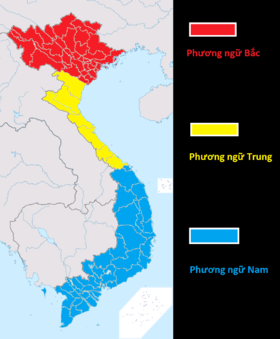
The Vietnamese language features many accents, the three major dialects are those of the North, Center, and South with major differences in phonology and vocabulary. Due to cultural prominence, the Hanoi and Saigon accents are mostly intelligible to speakers from other regions. The Central accent, in particular from the provinces of Nghệ An, Hà Tĩnh, Quảng Bình, Quảng Nam, and Quảng Ngãi is often unintelligible to speakers outside of these regions.
Differences in these accents lie in several different factors, including but not limited to the following:
- Pronunciation of words, an example would be: a Hanoi <d> is pronounced like the English /z/ while a Saigon <d> is pronounced like the English /j/.
- Northern Vietnamese has the full 6 tones, whereas Southern Vietnamese has only 5 (merging two of the tones into one)
- Words ending in "nh" are pronounced differently between North and South (See Vietnamese phonology for details)
- Merging of the "tr" and "ch" sounds in Northern Vietnamese
- Some differences in vocabulary between different regions
- Northerners speak with a higher-pitched accent [citation needed].
- Central Vietnamese (in the North-Central Coast, from Nghệ An to Huế) speak in a high-pitched, diverse accents. In areas of Nghệ An, people living in different villages could speak in completely different accents.
- Southerners, along with the South Central Coast provinces of Bình Định, Phú Yên, Khánh Hòa, Ninh Thuận and Bình Thuận, speak in a lower-pitched, more monotone accent [citation needed], which is also found in the accents of various aboriginal languages spoken by Montagnard hill tribe ethnicities.
In Central Vietnamese, the number of tones is reduced to 5 (om Quảng Trị and Huế accents) or only 4 (in Hà Tĩnh, Nghệ An and Quảng Bình accents). One of the distinctive feature of Central Vietnamese and Quảng Nam accent is the use of a different set of particles and pronouns, making it stand apart from Northern and Southern Vietnamese. For example, chi, mô, tê, răng and rứa (what, where, that, why and thus) are used instead of gì, đâu, kìa, sao and vậy in Standard Vietnamese.
While these differences may seem superficial to non-Vietnamese speakers, even the difference in phonology. The vocabulary of the different regions also differs, and the difference between Northern and Southern Vietnamese is quite striking.
Kinship terms are especially affected, as each term has a subtly different meaning in each region. In the South, the eldest child in a family is referred by the ordinal number two, while in the North "number two" refers to the second-eldest child. The vocabularies of the different regions also differ. Vocabulary differences can be confusing as sometimes the same word could have different meaning in each dialects. For example, the word mận refers to two different fruits: it is used for Prunus salicina (a type of plum) in the North, while in the South it refers to Syzygium samarangense (the rose apple). Similarly; chè is a dessert in Southern Vietnamese but in the Northern it has two meanings: tea and chè, ốm means sick in Northern Vietnamese and thin in Southern Vietnamese. "bông" refers to flower in Southern Vietnamese but means cotton in Northern Vietnamese, and the word địt refers to flatuence in the South but means "fuck" in the North.
Differences in climate
[edit]
Vietnam is located in both a tropical and a temperate zone. It is characterized by strong monsoon influences, but has a considerable amount of sun, a high rate of rainfall, and high humidity. Regions located near the tropics and at high altitudes are endowed with a temperate climate.[9]
Northern Vietnam has a humid subtropical climate, with a full four seasons, with much cooler temperatures than in the South (which has a tropical savanna climate), as well as winters that can get quite cold, sometimes with frost. The lowest temperature reached in Hanoi was 2.7 °C (36.9 °F) in 1955.[10] Snow can even be (rarely) found in the high mountains of Northern Vietnam such as Sapa and Mount Mẫu Sơn when the region receives a strong cold wave.
Central and Southern Vietnam, which have a tropical climate, have only two main seasons: a dry season and a rainy season.
Miscellaneous cultural differences
[edit]- While Southern Vietnamese often ring in the Tết Nguyên Đán with yellow mai (Ochna integerrima) blossoms, Northern Vietnamese often prefer hoa đào (peach) blossoms.
Names
[edit]During French Indochina these regions were named in Vietnamese as Bắc Kỳ (北圻), Trung Kỳ (中圻), and Nam Kỳ (南圻); these terms itself had originated from the Minh Mạng period. During the Empire of Vietnam (a Japanese-sponsored state) these regions were renamed to Bắc Bộ (北部), Trung Bộ (中部), and Nam Bộ (南部) by Prime Minister Trần Trọng Kim.[11] Following the creation of the State of Vietnam and the establishment of its government, the Chief of State Bảo Đại signed the two ordinances related to the administration and local governance of the State of Vietnam, namely Ordinance No. 1 ("Organisation and Operation of civil authorities in Vietnam") and Ordinance No. 2 ("Statutes of Government office").[12] These ordinances renamed the regions to Bắc Việt (北越), Trung Việt (中越), and Nam Việt (南越).[12] Later on 4 August 1954 the government of the State of Vietnam enacted Ordinance No. 21 which renamed the regions to Bắc Phần (北分), Trung Phần (中分), and Nam Nhần (南分).[12] On 24 October 1956 the South Vietnamese president Ngô Đình Diệm officially abolished the three region system as the regions were divided into smaller regions in South Vietnam.[13]
See also
[edit]- Nam tiến
- Northern and Southern dynasties (Vietnam)
- Vietnam under French rule: Tonkin, Annam, and Cochinchina
- Geographical exonyms: Tonkin and Cochinchina
- Trịnh–Nguyễn War: Đàng Ngoài and Đàng Trong
- Vietnam War: North Vietnam and South Vietnam
References
[edit]- ^ David Brown (2012-02-18). "Vietnam's press comes of age". Asia Times. Archived from the original on 2012-02-17.
- ^ a b c d e Ben Stocking (2007-02-26). "Shall the South rise again?". Associated Press. Retrieved 2009-05-27.
- ^ (in Vietnamese) Hanoi People's Committee. "Hà Nội thanh lịch". Retrieved 2009-05-27.
- ^ a b c (in Vietnamese) Hồng Phúc (2009-01-16). "Yêu Hà Nội, thích Sài Gòn". Saigon Times Online. Retrieved 2009-05-27.
- ^ a b Stocking, Ben (March 4, 2007). "North-South divide persists in Vietnam". Los Angeles Times. Retrieved 3 April 2014.
- ^ Clare Arthurs (December 31, 2001). "Vietnam's dog meat tradition". BBC News. Retrieved 2007-05-10.
- ^ AP (July 5, 2013). "Vietnam gang stole 4000 cats for meat". The Australian. Retrieved 8 December 2013.
- ^ Masis, Julie (July 22, 2010). "Why do Vietnamese keep cats on a leash? (Hint: What's for dinner?)". CS Monitor. Retrieved 8 December 2013.
- ^ "Climate". Vietnam National Administration of Tourism. Archived from the original on 9 November 2018. Retrieved 9 November 2018.
- ^ [1]: Lowest temperature recorded in Hanoi
- ^ Vu Ngu Chieu (February 1986). "The Other Side of the 1945 Vietnamese Revolution: The Empire of Viet-Nam". Journal of Asian Studies. 45 (2): 303–304.
- ^ a b c Royal Woodblocks of Nguyễn Dynasty – World documentary heritage (2021). "Significant collections § Fonds of the Phủ Thủ hiến Trung Việt or Office of the Governor of Trung Viet". mocban.vn. The National Archives Center No. 4 (State Records and Archives Department of Vietnam). Retrieved 30 March 2021.
- ^ Royal Woodblocks of Nguyễn Dynasty – World documentary heritage (2021). "Significant collections § FONDS OF THE TÒA ĐẠI BIỂU CHÁNH PHỦ TẠI TRUNG NGUYÊN TRUNG PHẦN OR THE OFFICE OF THE GOVERNMENT'S REPRESENTATIVE IN CENTRAL MIDLANDS". mocban.vn. The National Archives Center No. 4 (State Records and Archives Department of Vietnam). Retrieved 31 March 2021.
 KSF
KSF